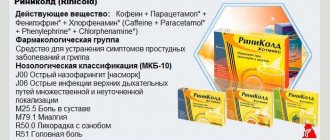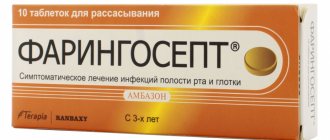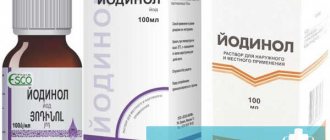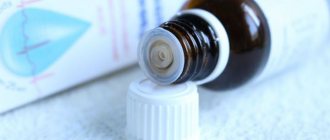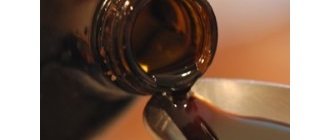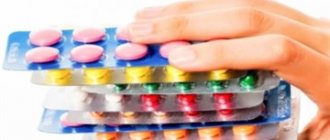Prohibited during pregnancy
Prohibited during breastfeeding
Has restrictions for children
Has restrictions for older people
Has limitations for liver problems
Has limitations for kidney problems
One of the first symptoms that allows one to suspect the development of a pathological process in the human body is pain. This is a subjective unpleasant feeling that significantly reduces the quality of life and ability to work. In this regard, there is a need to take painkillers. Taking combined analgesics, for example Askofen P, helps relieve pain quite quickly.
Pharmacodynamics and pharmacokinetics
A combined drug whose effectiveness is ensured by its constituent components.
Acetylsalicylic acid has a noticeable analgesic, antipyretic and anti-inflammatory effect, inhibits platelet aggregation .
Paracetamol also exhibits antipyretic and analgesic effects.
Caffeine increases reflex excitability of the spinal cord, stimulates respiratory and vasomotor functions, dilates blood vessels , muscles, heart, brain, kidneys, and reduces platelet aggregation . In addition, taking caffeine helps reduce drowsiness and fatigue, increase performance, and so on.
As a result of oral administration, almost 90% of the drug is absorbed. In this case, the maximum concentration of substances in the serum is achieved at different times: paracetamol - within an hour, caffeine - 2.5 hours, acetylsalicylic acid - 1-2 hours.
Almost 80% of the acidic active substances are eliminated from the body by the kidneys.
General information about the drug
To eliminate pain of moderate intensity, according to international recommendations, combination medications are used. They contain substances that enhance the effect of the main components. These drugs have antipyretic and anti-inflammatory effects, which allows them to act on the cause of unpleasant symptoms.
Drug group, INN, scope of application
In accordance with the latest international pharmacological classification of drugs, Askofen P is included in the group of combined analgesics-antipyretics. According to the ATC classification, it has code N02B A51, a group of various combinations of acetylsalicylic acid without psycholeptics. International unclassified name – Acidum Acetylsalicylici + Paracetamol + Caffeinum.
Askofen P against pain
In most cases, the use of Askofen P is resorted to when monocomponent drugs are ineffective and there is severe pain, which significantly impairs a person’s psycho-emotional state and ability to work.
Release forms and prices for the drug, average in Russia
Askofen P is an inexpensive painkiller that is produced by a Russian pharmaceutical company in tablet form. Each tablet has a flat-cylindrical shape with a dividing strip on one side.
The color can vary from white to light cream, mild marbling is allowed, and there is no specific smell. Sold in cardboard packages containing 1 or 2 blisters of 10 tablets. Sold in pharmacies without a doctor's prescription.
The average price for package No. 10 differs in different regions, as shown in the table.
| City | Price in rubles |
| Moscow and region | 36,9-38 |
| Saint Petersburg | 32-34,5 |
| Caucasus | 28,5-29 |
| Near East | 30-32,5 |
| Ural | 27,5-29 |
| Krasnodar region | 29,7-35,3 |
Compound
The drug contains two non-steroidal anti-inflammatory substances in different quantities (200 mg) - acetylsalicylic acid (the more common name is aspirin) and paracetamol. Their active effect is enhanced by 40 mg of caffeine.
Potato starch, talc, low molecular weight polyvinylpyrrolidone, silicone, petroleum jelly, citric acid monohydrate, calcium stearate and stearic acid are used as a base to give shape and color, as well as to protect active ingredients from environmental influences.
Pharmacodynamics and pharmacokinetics
Acetaminophen (paracetamol) and acetylsalicylic acid (aspirin) belong to the group of non-steroidal anti-inflammatory drugs. The mechanism of action of paracetamol is associated with blocking the action of both forms of the cyclooxygenase enzyme, which leads to a decrease in the concentration of inflammatory mediators - prostaglandins. The antipyretic and analgesic effect of acetaminophen is due to its effect on the thermoregulation and pain centers located in the hypothalamus.
Effects of Askofen P
Aspirin has a local anti-inflammatory and analgesic effect by inhibiting the synthesis of prostaglandins in peripheral tissues. Reduces exudation, swelling and hyperthermia in inflamed tissues, reduces the permeability of capillary walls.
The antiaggregation effect of acetylsalicylic acid is associated with an irreversible blocking of the activity of the enzyme cyclooxygenase type 1 and a decrease in the production of thromboxane A2, a mediator of platelet aggregation and degranulation.
Caffeine is a strong adaptogen and psychostimulant. Strengthens the anti-inflammatory and antipyretic properties of the main components, has a general tonic effect on the body, reduces drowsiness and fatigue, and increases working capacity.
Effects of caffeine on the body
After oral administration, the expected clinical effect occurs after 15-20 minutes. Absorption of the components occurs in the stomach and small intestine within 30 minutes. It is excreted from the body in the urine after metabolism in the liver.
Analogs
One of the popular domestic analogues of the drug is Citramon Ultra from the Russian company Obolenskoye FP. The average price for 10 tablets is from 82 rubles. Available in packs of 10, 15 and 30 tablets. Capsules Citramon-ExtraCap, Pharmstandard, Russia are also in demand. They have a faster and longer lasting effect. Price – from 88 rubles for 10 capsules.
The most expensive is the imported product Migrenol Extra. An increased dosage (0.25 g of aspirin, 0.5 g of paracetamol and 65 mg of caffeine) allows you to get the fastest and most long-lasting clinical effect. The product effectively eliminates signs of inflammation, fever, and relieves pain. Packages of 16 tablets are available in pharmacy chains and cost from 193 rubles.
Askofen-P during pregnancy
It should be noted that this drug is not recommended for use during pregnancy, especially in the 1st and 3rd trimester. A one-time use of the medicine in the 2nd trimester of pregnancy is allowed, but if it is clearly established that it will not cause harm to the fetus.
As is known, taking the drug in the first trimester can cause fetal malformation in the form of cleft palate caused by the teratogenic effect of acetylsalicylic acid.
In the third trimester, there remains a possibility of inhibition of labor, closure of the ductus arteriosus in the unborn baby, causing vascular hyperplasia in the lungs and hypertension in the circulatory vessels.
special instructions
Children should not be prescribed medications containing acetylsalicylic acid, since in the case of a viral infection they can increase the risk of Reye's syndrome. Symptoms of Reye's syndrome are prolonged vomiting, acute encephalopathy, and liver enlargement.
With prolonged use of the drug, monitoring of peripheral blood and the functional state of the liver is necessary.
Since acetylsalicylic acid slows down blood clotting, the patient, if he is undergoing surgery, must notify the doctor in advance about taking the drug.
In patients with hypersensitivity or asthmatic reactions to salicylates or their derivatives, acetylsalicylic acid can only be prescribed with special precautions (in an emergency setting).
Acetylsalicylic acid in low doses reduces the excretion of uric acid. In patients with a corresponding predisposition, this can in some cases provoke an attack of gout.
During treatment, you should stop drinking ethanol (increased risk of gastrointestinal bleeding).
Acetylsalicylic acid has a teratogenic effect; when used in the first trimester of pregnancy, it leads to a malformation - cleft palate; in the third trimester - to inhibition of labor (inhibition of prostaglandin synthesis), to closure of the ductus arteriosus in the fetus, which causes hyperplasia of the pulmonary vessels and hypertension in the vessels of the pulmonary circulation.
It is excreted in breast milk, which increases the risk of bleeding in the baby due to impaired platelet function.
Contraindications for use
- intolerance to the drug or its components;
- various gastrointestinal lesions;
- disorders of the liver or kidneys;
- abnormalities in the functioning of the respiratory system, for example, with asthma;
- dissecting aortic aneurysm;
- some disorders of the nervous and cardiovascular system;
- age less than 15 years;
- lactation, pregnancy and so on.
Possible side effects and overdose
Askofen P can cause negative reactions from various systems and organs:
- The drug increases the acidity of gastric juice, which leads to side effects such as exacerbation of gastritis, duodenitis and peptic ulcers. This is accompanied by the appearance of heartburn, pain in the epigastric region, nausea, stool disorders (diarrhea, constipation).
From the cardiovascular system, an increase in the frequency and strength of heartbeats, and the risk of developing hypertensive crises are noted.- The development of hemorrhagic syndrome is possible: nosebleeds, bleeding gums, hematomas, hemorrhagic stroke.
- Allergic reactions and intolerance to the components of the drug are manifested by skin itching, rash, urticaria, the development of Quincke's edema, and anaphylactic shock. The most dangerous manifestation is the development of Lyell and Stevens-Johnson syndromes.
- The development of renal failure is directly proportional to the dose of paracetamol used.
- Patients with aspirin-induced asthma may develop attacks of bronchospasm, cough, and shortness of breath.
- Sometimes mood swings and deterioration in general condition are observed: weakness, drowsiness, loss of ability to work, irritability, insomnia.
Side effects
When treated with this drug, various problems may arise in the gastrointestinal tract in the form of: anorexia, nausea, vomiting, gastralgia, diarrhea, erosive and ulcerative damage, bleeding. liver or kidney failure, tachycardia and increased blood pressure is also possible
Long-term use of the medication causes: dizziness, tinnitus, headache, hypocoagulation, various undesirable syndromes and liver dysfunction .
Askofen tablets, instructions for use (Method and dosage)
As the instructions for use of Askofen-P indicate, these tablets are prescribed to be taken after meals 2-3 times a day in an amount of 1-2 pieces. In this case, the maximum daily dosage should not exceed 6 pieces, and the break should be less than 4 hours.
Considering the indications for the use of Askofen, you need to observe some features of administration:
- It is better to take the tablets with milk, regular warm or mineral water;
- patients with impaired renal or liver function need to increase the interval between taking the medicine - from 6 hours.
In addition, the course of pain therapy should not exceed 5 days and treatment of fever should not exceed 3 days. In other cases, the duration of treatment and dosage is determined by the doctor.
Indications for use of Askofen
This drug is recommended for headaches, colds, and neuralgia. It should be noted that the use of Askofen is increasingly being replaced by the use of Askofen P and Askofen L, which is due to the greater safety of paracetamol compared to phenacetin, as well as a more effective combination of components included in these drugs.
Askofen P is prescribed for:
- moderate pain syndrome (toothache, migraine, headache, arthralgia, neuralgia, painful menstruation);
- febrile conditions caused by rheumatic and colds.
Overdose
In case of overdose, the following may occur:
- nausea, vomiting, pain in the gastrointestinal tract;
- sweating, pale skin;
- tachycardia;
- tinnitus;
- drowsiness, collapse, convulsive state;
- bronchospasm, breathing problems and so on.
If there is a suspicion of poisoning , then you need to urgently call for medical help. Usually the victim's stomach is washed and adsorbents are prescribed.
Interaction
Simultaneous treatment with Askofen-P leads to increased effects of heparin , reserpine, indirect anticoagulants, steroid hormones and some hypoglycemic agents . It is also likely that the effectiveness of furosemide, spironolactone , and antihypertensive and anti-gout drugs , which help remove uric acid from the body, will decrease.
An increase in side effects of glucocorticosteroids , methotrexate sulfonylurea derivatives , as well as non-steroidal anti-inflammatory drugs and non-narcotic analgesics was noted.
It is not recommended to combine this medicine with barbiturates , antiepileptic drugs, zidovudine, rifampicin and alcohol-containing drinks, because there is a possibility of developing a hepatotoxic effect.
The effect of paracetamol increases the elimination period of chloramphenicol by almost 5 times. As for caffeine, it helps accelerate the absorption of ergotamine.
Combination therapy with Salicylamide and other stimulants of microsomal oxidation promotes the production of toxic metabolites of paracetamol , which negatively affect liver function.
Simultaneous use with Metoclopramide enhances the absorption of paracetamol . Repeated use can increase the effect of anticoagulants.
Askofen-P® (Ascophen-P)
Acetylsalicylic acid
Other non-steroidal anti-inflammatory drugs:
Increased damaging effect on the mucous membrane of the gastrointestinal tract (GIT), increased risk of developing gastrointestinal bleeding. If simultaneous use is necessary, it is recommended to use gastroprotectors for the prevention of NSAID-induced gastrointestinal ulcers, therefore simultaneous use is not recommended.
Glucocorticosteroids:
Increased damaging effect on the gastrointestinal mucosa, increased risk of gastrointestinal bleeding. If simultaneous use is necessary, it is recommended to use gastroprotectors, especially in persons over 65 years of age, therefore simultaneous use is not recommended.
Oral anticoagulants (for example, coumarin derivatives):
Acetylsalicylic acid (ASA) may potentiate the effect of anticoagulants. Clinical and laboratory monitoring of bleeding time and prothrombin time is necessary. Simultaneous use is not recommended.
Thrombolytics:
Increased risk of bleeding. The use of ASA in patients within the first 24 hours after an acute stroke is not recommended. Simultaneous use is not recommended.
Heparin:
Increased risk of bleeding. Clinical and laboratory monitoring of bleeding time is required. Simultaneous use is not recommended.
Platelet aggregation inhibitors (ticlopidine, paracetamol, clopidogrel, cilostazol):
Increased risk of bleeding. Clinical and laboratory monitoring of bleeding time is required. Simultaneous use is not recommended.
Selective serotonin reuptake inhibitors (SSRIs):
Concomitant use may affect blood clotting or platelet function, resulting in an increased risk of bleeding in general, and gastrointestinal bleeding in particular, so concomitant use is not recommended.
Phenytoin:
ASA increases the plasma concentration of phenytoin, which requires its monitoring.
Valproic acid:
ASA disrupts its binding to plasma proteins and, therefore, can lead to an increase in its toxicity. Monitoring of plasma concentrations of valproic acid is necessary.
Aldosterone antagonists (spirolactone, canrenoate):
ASA may reduce their activity due to impaired sodium excretion; proper control of blood pressure is necessary.
Loop diuretics (eg furosemide):
ASA can reduce their activity due to impaired glomerular filtration caused by inhibition of prostaglandin synthesis in the kidneys.
Concomitant use of nonsteroidal anti-inflammatory drugs (NSAIDs) may lead to acute renal failure, especially in dehydrated patients.
If diuretics are used concomitantly with ASA, ensure the patient is adequately rehydrated and monitor renal function and blood pressure, especially when diuretic treatment is initiated.
Antihypertensive drugs (ACE inhibitors, angiotensin II receptor antagonists, slow calcium channel blockers):
ASA may reduce their activity due to inhibition of prostaglandin synthesis in the kidneys. Concomitant use may lead to acute renal failure in elderly or dehydrated patients. If diuretics are used concomitantly with ASA, it is necessary to ensure adequate rehydration of the patient and monitor renal function and blood pressure. When used concomitantly with verapamil, bleeding time should be monitored.
Uricosurics (eg probenecid, sulfinpyrazone):
ASA can reduce their activity by inhibiting tubular reabsorption, leading to high plasma concentrations of ASA.
Methotrexate ≤ 15 mg/week:
ASA, like all NSAIDs, reduces the tubular secretion of methotrexate, increasing its plasma concentration and, thus, toxicity. In this regard, the simultaneous use of NSAIDs in patients receiving high doses of methotrexate is not recommended (see section "Contraindications"). In patients taking low doses of methotrexate, the risk of interaction between methotrexate and NSAIDs should also be considered, especially if renal function is impaired. If combination therapy is necessary, it is necessary to monitor a general blood count, liver and kidney function, especially in the first days of treatment.
Sulfonylureas and insulin:
ASA enhances their hypoglycemic effect, therefore, when taking a high dose of salicylates, it may be necessary to reduce the dose of hypoglycemic drugs. It is recommended to monitor blood glucose levels more often.
Alcohol
:
Increases the risk of gastrointestinal bleeding; simultaneous use should be avoided.
Paracetamol
Inducers of liver microsomal enzymes or potentially hepatotoxic substances (for example, alcohol, rifampicin, isoniazid, hypnotics and antiepileptic drugs, including phenobarbital,
phenytoin and carbamazepine
):
Increased toxicity of paracetamol, which can lead to liver damage even at non-toxic doses of paracetamol, therefore liver function should be monitored. Simultaneous use is not recommended.
Chloramphenicol
:
Paracetamol may increase the risk of increased chloramphenicol concentrations. Simultaneous use is not recommended.
Zidovudine
:
Paracetamol may increase the tendency to develop neutropenia, and therefore hematological parameters should be monitored. Simultaneous use is possible only with the permission of a doctor.
Probenecid
:
Probenecid reduces the clearance of paracetamol, which requires a reduction in the dose of paracetamol. Simultaneous use is not recommended.
Indirect anticoagulants:
Repeated use of paracetamol over a period of more than one week increases the anticoagulant effect. Occasional use of paracetamol has no significant effect.
Propantheline and other drugs that slow down gastric emptying:
Reduce the rate of absorption of paracetamol, which may delay or reduce rapid pain relief.
Metoclopramide and other drugs that accelerate gastric emptying:
Increases the rate of absorption of paracetamol and, accordingly, the effectiveness and onset of analgesic action.
Cholestyramine
:
Reduces the rate of absorption of paracetamol, therefore, if maximum analgesia is necessary, cholestyramine is taken no earlier than 1 hour after taking paracetamol.
Caffeine
Hypnotics (eg, benzodiazepines, barbiturates, H1 blockers):
Concomitant use may reduce the hypnotic effect or reduce the anticonvulsant effect of barbiturates, so concurrent use is not recommended. If simultaneous use is necessary, it is advisable to take the combination in the morning.
Lithium
:
Caffeine withdrawal may increase plasma lithium concentrations because caffeine increases the renal clearance of lithium, so lithium dosage reduction may be necessary when caffeine is withdrawn. Simultaneous use is not recommended.
Disulfiram
:
Patients being treated with disulfiram should be warned to avoid caffeine to avoid the risk of worsening alcohol withdrawal syndrome due to the stimulating effects of caffeine on the cardiovascular and central nervous systems.
Ephedrine-like substances:
Increased risk of developing drug addiction. Simultaneous use is not recommended.
Sympathomimetics or levothyroxine:
Due to mutual potentiation, they can enhance the chronotropic effect. Simultaneous use is not recommended.
Theophylline
:
Concomitant use reduces the excretion of theophylline.
Antibacterial drugs from the quinolone group, enoxacin and pipemidic acid, theobinafine. cimetidine, fluvoxamine and oral contraceptives:
Increased half-life of caffeine due to inhibition of hepatic cytochrome P450, therefore patients with impaired liver function, cardiac arrhythmias and latent epilepsy should avoid caffeine.
Nicotine, phenytoin and phenylpropanolamine:
Reduces the terminal half-life of caffeine.
Clozapine
:
Caffeine increases clozapine serum concentrations, likely through both pharmacokinetic and pharmacodynamic mechanisms. Monitoring of serum concentrations of clozapine is necessary. Simultaneous use is not recommended.
Analogs
Level 4 ATC code matches:
Acetylsalicylic acid
Aspirin-S
Citropak
Aspirin
Citramon
Coficil-Plus
Farmadol
Cefekon N
Aquacitramon
Upsarin UPSA
Citrapack
Alca Prim
Thrombopol
Citrapar
The following drugs also have a similar effect: Orafen, Flexen, Diclovit, Artrosilene, Bofen and others.
Reviews about Askofen-P
As numerous patient reviews left on various forums show, this drug is an excellent, inexpensive and effective combination remedy. Many users have been taking Askofen tablets for a long time, which does not reduce the therapeutic effect, since they use them periodically.
At the same time, some patients ask what Askofen-P helps best with and how often can it be used? To this, experts answer that the tablets have equivalent analgesic, antipyretic and anti-inflammatory effects. However, when these unwanted symptoms do not disappear quickly, you need to consult a doctor.
In addition, there are many features and contraindications to taking this medicine. For example, Askofen Darnitsa is capable of exacerbating the manifestation of asthma more than other forms, causing the development of severe allergic reactions.
Does Ascofen increase or decrease blood pressure?
This drug is often taken by people suffering from arterial hypotension , that is, low blood pressure, in order to get rid of this disease. However, they claim that such treatment was recommended to them by a doctor. Most patients are satisfied with the effect produced.
Of course, this combination of substances includes a small dosage of caffeine , which is not capable of having a stimulating effect on the central nervous system, but normalizes cerebral vascular tone and accelerates blood flow. Therefore, patients with high blood pressure should take these pills with caution, and people with low blood pressure should still not abuse such therapy.
pharmachologic effect
Combined drug.
Acetylsalicylic acid has an antipyretic and anti-inflammatory effect, relieves pain, especially caused by the inflammatory process, and also moderately inhibits platelet aggregation and thrombus formation, improves microcirculation at the site of inflammation.
Caffeine increases the reflex excitability of the spinal cord, stimulates the respiratory and vasomotor centers, dilates the blood vessels of skeletal muscles, brain, heart, kidneys, reduces platelet aggregation; reduces drowsiness, fatigue, increases mental and physical performance. In this combination, caffeine in a small dose has virtually no stimulating effect on the central nervous system, but helps normalize cerebral vascular tone and accelerate blood flow.
Paracetamol has an analgesic, antipyretic and extremely weak anti-inflammatory effect, which is associated with its effect on the thermoregulation center in the hypothalamus and a weak ability to inhibit the synthesis of prostaglandins in peripheral tissues.
Askofen-P price, where to buy
This medicine is available to almost all patients, since in Russian pharmacies its price starts from 14 rubles.
- Online pharmacies in RussiaRussia
- Online pharmacies in KazakhstanKazakhstan
ZdravCity
- Askofen-P painkiller tablet.
10 pcs. Pharmstandard-Leksredstva OJSC 35 rub. order - Askofen-P painkiller tablet. 20 pcs. Pharmstandard-Leksredstva OJSC
57 RUR order
show more

